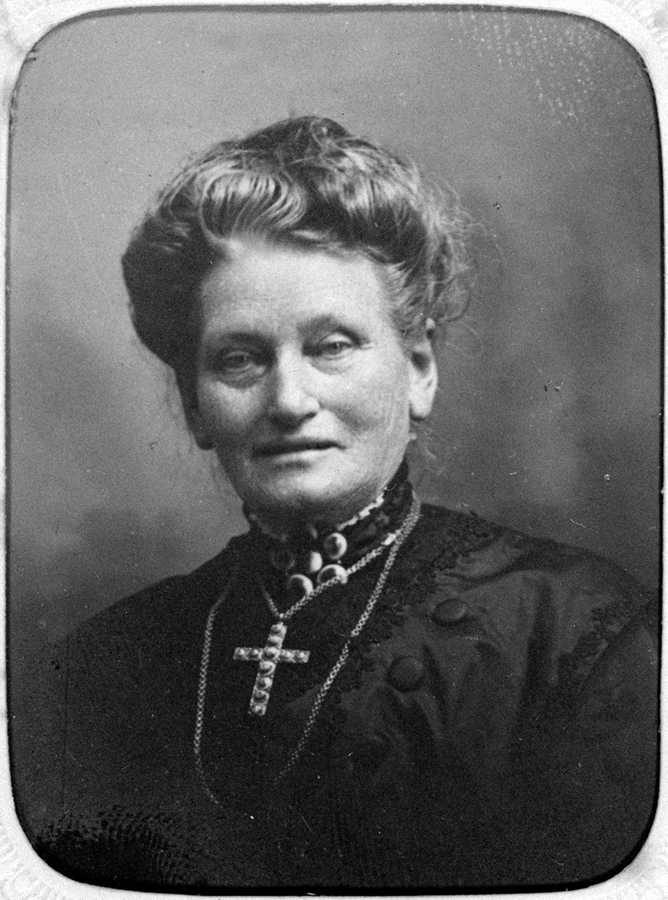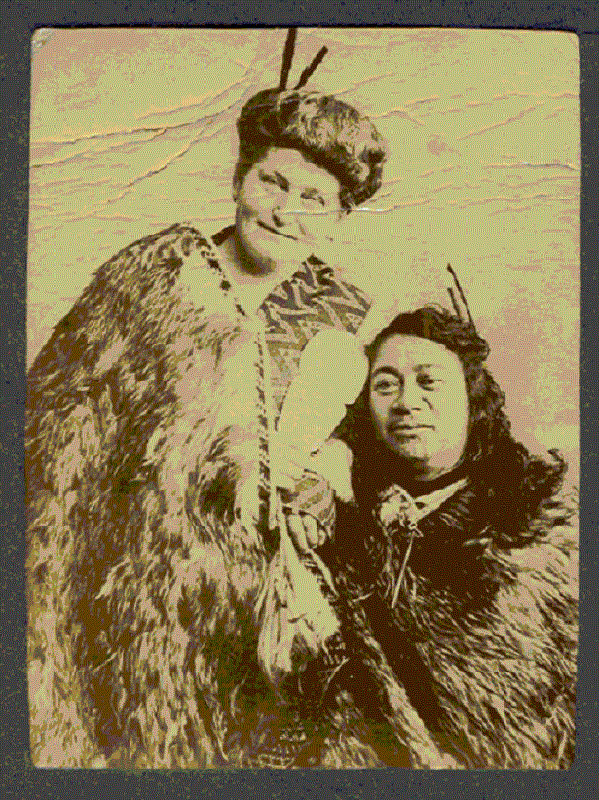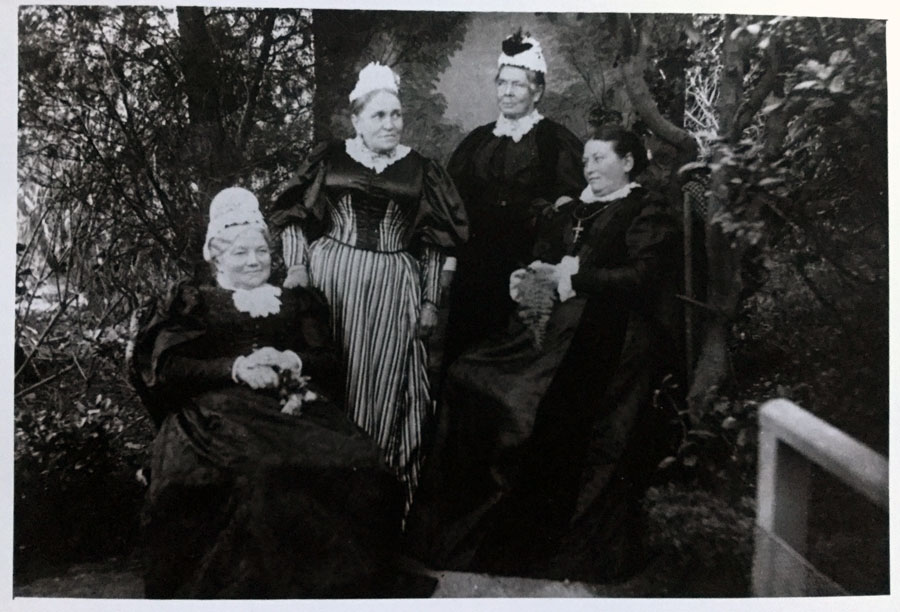
Biography contributed by Rachel Baskerville (great-great-granddaughter of Louisa's neice Miriam Ballard)
Aunt Lou was an admired and popular woman in the Manawatū in colonial New Zealand, known as the first Mayoress of Palmerston North, but had suffered the tragedy of two children both dying in infancy. She was very kind to all her nieces and nephews, especially my great grandmother Miriam Ballard. The Te Manawa Museum has a display of her contribution to colonial society as a Suffragist.
Louisa’s mother was Elizabeth Cooze, born 28 January 1802 in Somerset, England. Her father Henry Gregory Buck was born on 6 April 1808, was a miner in Somerset, and he married Elizabeth on 6th October 1833. His later business as a 'Blacksmith and Whitesmith' in Molesworth Street, Wellington, reflected a miner’s interest in smelting and iron making, integral to blacksmithing. They had three children together in Somerset before emigrating to New Zealand on one of the very early settler migration boats, the Birman. When Henry and Elizabeth Buck arrived in 1842 it appears they settled in Molesworth Street, in Thorndon, Wellington. Louisa Matilda Buck was born on 29 January 1844 in Wellington. She was the last of Elizabeth’s nine children.
Louisa grew up in a busy household with older children. 1865 was the year that Louisa married George Snelson (1837–1901), in the St Paul’s church room in Thorndon (what we now call the 'Old St Pauls' pro-Cathedral was not opened until 1866). George had immigrated to New Zealand, arriving in Wellington on 21st February 1863 aboard the Earl of Windsor. Like his future father-in-law, he worked in the metal and engineering trades, and advertised weekly hardware or newly-arrived items for sale to the early colonial town (William Cable) on Waterloo Quay, Wellington.
Lou Snelson features as a chapter in: Petticoat Pioneers: North Island Women of the Colonial Era: Book Two (1975) by Miriam MacGregor, and this was no doubt drawn upon in The Dictionary of New Zealand Biography (DNZB) entry on the Snelsons by Roger Wigglesworth. But Petticoat Pioneers states Louisa was born in England before emigration, also as stated in her Obituary, but this is not the case. As noted above, she was born in the very early Wellington settlement in 1844. The Petticoat Pioneers chapter informed a display as illustrated above in the Te Manawa Museum (Palmerston North), and the Library there also holds Louisa’s scrapbook – described by their curator as '310 pages stuffed chock full'.
From the DNZB: ‘Louisa Snelson's name was as closely associated as George's with social and religious initiatives in Palmerston North. Anglican Church services were held at their home and store from October 1872, and on 29th September 1875 Louisa laid the foundation stone for All Saints', the first Anglican Church in the town. Louisa was Sunday school teacher there from 1877 and also maintained close contact with Christian Maori at Awapuni. The Snelsons campaigned vigorously to have land set aside for a school in Palmerston North. The couple (more particularly Louisa) led the intensive fund-raising for a public hospital, which opened on 21st November 1893'.
Louisa took a particular interest in the welfare and education of local Māori, and was said to be a fluent speaker of Te Reo Māori. In 1907 she shared in the unveiling of the monument to Rangitane chief Te Peeti Te Aweawe, which stands in The Square in Palmerston North; she had commenced a campaign for the statue in 1890. The photograph of Lou with Peggy Papakura on this website pertains to her ongoing relationship with the local iwi. Hand-written notes by my aunt Diana Highet stated that ‘Mrs Snelson was adopted by the local tribe, by a blood transfusion from the Rangitāne in 1879’.
'Louisa was left in a parlous financial position after George died. A collection was taken to assist her, but she soon had to sell her home and in October 1903 she moved to Sydney, Australia. Little is known of her time there. She returned to Palmerston North several years later and was again involved with fund-raising for various community causes. Because of her personal circumstances she was compelled to earn money by selling flower paintings and giving private art lessons. During her last years she lived in private hotels and with friends' (DNZB).
In the 1914 census she was living (possibly boarding) at Cliff House, a very large building at 1 Milne Terrace, Island Bay, in Wellington. Katherine Mansfield writes of 'drinking a great deal of tea and eating a preposterous amount of bread and apricot jam at a little place called Cliff House' on her ramblings in Island Bay a decade earlier.
Louisa died on 14 December 1919 while visiting Whanganui, at 75 years. Her funeral, too, was a notable local event. She is remembered very fondly by her nieces and nephews, including my great-grandmother, Miriam Ballard (née Levy) who also signed the Suffrage petition. I have no doubt she was also instrumental in galvanising widespread support for the Suffrage Petition in 1892-1893.
Sources
The Suffragist display in the Manawatū museum Te Manawa, with her photograph and hymn book
Petticoat Pioneers: North Island Women of the Colonial Era: Book Two (1975) by Miriam MacGregor
Roger Wigglesworth. 'Snelson, George Mathew', Dictionary of New Zealand Biography, first published in 1993. Te Ara – the Encyclopaedia of New Zealand, https://teara.govt.nz/en/biographies/2s34/snelson-george-mathew (accessed 26 August 2020)
Louisa’s scrapbook (310 pages) at the Palmerston North City Library
Obituary, Manawatu Times, Volume XLIII, Issue 1442, 16 December 1919
Images

Louisa Matilda Snelson, 1914 (Manawatū Heritage)

Louisa Snelson and Peggy Papakura

Louise Snelson is seated on the far right of this photo, visiting her sisters. Her half-sister Jane Levy is seated left, then her older sister Leah McKenzie, and her half-sister Ann Jackson next to Lou.
- Jane married Solomon Levy and lived at 26 Brougham Street near Courtney Place. They had thirteen children of whom eight survived to adulthood. Jane and Solomon were my great great grandparents, and their daughter Miriam Ballard (née Levy, who also signed the Petition) was my great grandmother.
- Leah (1836–1898) married Thomas Wilmor McKenzie (1827–1911) on 22 June 1853. When Lean had arrived in 1842 on the Petone foreshore, aged 6, she was carried ashore from the surf boat by McKenzie, whom she wedded when she had reached the age of 17. McKenzie had arrived on the ship Adelaide in February 1840. Three children died in infancy in January 1865 and another in 1869. Thomas was very instrumental in the development of Wellington City, as a landowner, journalist, newspaper owner, and together they were known for leading many philanthropic activities. When she died the newspaper noted: 'The news of Mrs. McKenzie's death was received in the city early this morning with feelings of genuine regret. During her lengthened residence in Wellington she became known to thousands of people, and by all who knew her she was loved and respected. She leaves five sons and four daughters (all grown up), and for them and Mr. McKenzie, one of the oldest and most respected of our settlers, much sympathy will be felt. Mrs. McKenzie was of a most amiable disposition, and was known far and wide for her benevolence'.
- Ann (1831–1909) married Edwin Jackson, an early Petone pioneer. Ann Jackson also signed the Suffrage Petition (domiciled in Taita).
It could be said that these four sisters were all important feminist influences in early colonial Wellington and Manawatū, but Lou was possibly the most influential of them all.
Click on sheet number to see the 1893 petition sheet this signature appeared on. Digital copies of the sheets supplied by Archives New Zealand.

Community contributions